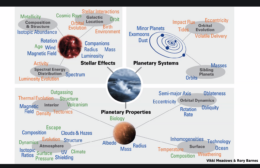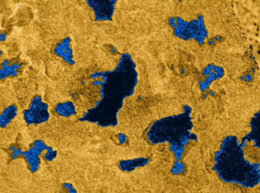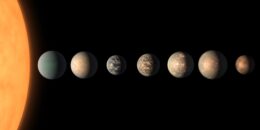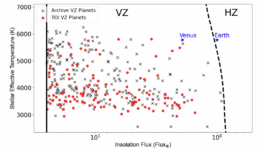Editor’s Note: This week we’ll be writing updates on selected events at the 56th Division for Planetary Sciences (DPS) meeting happening in Boise, Idaho, and online. The usual posting schedule for AAS Nova will resume on October 14th.
Table of Contents:
- Plenary Lecture: Planetary Habitability in the Solar System and Beyond (Stephen Kane)
- Plenary Lecture: From Venus to Exoplanets and Back Again (Cedric Gillmann)
- Plenary Lecture: ExoTitans: Connecting Solar System and Exoplanet Studies (Kathleen Mandt)
Plenary Lecture: Planetary Habitability in the Solar System and Beyond (Stephen Kane)
What is planetary habitability? This deceptively simple question posed by Stephen Kane (University of California, Riverside) is surprisingly controversial. Kane defines the answer as an assessment of the energy balance at a planet’s surface and what influences that balance over time. When looking at the vast sample of exoplanets — nearly 6,000 are currently known — Earth-size planets are common, opening up the possibility that the circumstances necessary for habitability are common as well.

Venus as seen by the Mariner 10 spacecraft. [NASA/JPL-Caltech]
Water is a recurring theme in discussions of habitability, since one framework within which to assess a planet’s energy balance is whether a planet is able to sustain liquid water on its surface. This framework is reasonable — and not unreasonably Earth-centric — because water is common throughout the universe, it’s a solvent in which biochemical reactions can take place, and it remains liquid up to (relatively) high temperatures, allowing chemical reactions necessary for life to proceed quickly.

The multitude of factors that could impact planetary habitability. What this graphic doesn’t show — and what’s critical to find out — is the relative importance of these factors and the connections between them. Click to enlarge. [Slide by Stephen Kane; originally from Vicky Meadows and Rory Barnes]
Atmospheric loss is important when considering exoplanets as well. In the TRAPPIST-1 system, which is famous for containing seven terrestrial planets, three or four of which are in their star’s habitable zone, recent JWST observations suggest that the two planets closest to the star have little to no atmosphere. (A hazy or cloudy atmosphere is possible for TRAPPIST-1 c, but TRAPPIST-1 b is extremely unlikely to have any kind of atmosphere.)
Another consideration for exoplanetary systems is the presence or absence of giant planets. Our solar system may be unusual among planetary systems because it contains four giant planets beyond the snow line (the distance from the Sun at which water exists as ice). Many other known exoplanet systems contain giant planets closer to their stars, which may prevent Earth-size planets from attaining stable orbits in the habitable zone. However, a well-placed giant planet may be critical for the habitability of Earth-like planets; giant planets positioned beyond the snow line can transport volatiles (critically, water ice) into the inner solar system. While Jupiter has a nearly circular orbit, researchers see giant planets beyond the snow line with a wide range of orbital eccentricities — and it turns out that giant planets with more elliptical orbits are actually better at scattering volatiles toward would-be Earths.
In the conclusion, Kane added a rather somber comment about the challenge of assessing planetary habitability: modeling suggests that the three biggest factors determining Venus’s current uninhabitability are the incident solar flux, Venus’s slow rotation rate, and its lack of plate tectonics. A distant observer could easily pin down the first of those three factors, but the other two are difficult or impossible to determine from afar.
Plenary Lecture: From Venus to Exoplanets and Back Again (Cedric Gillmann)
Cédric Gillmann (ETH Zurich) brought the discussion back to Venus in the second talk of the session. Seen from afar, it would be very difficult to distinguish Venus from Earth because the two planets have similar basic properties. This fact led Venus to be a prominent target of early solar system exploration, with some observers expecting Venus to be a sort of warm and humid “space Florida.” Instead, images from the surface revealed Venus to be dry and lifeless, though more Earth-like than it seemed at first glance: the images showed basaltic (composed of volcanic rock) plains similar to those found on Earth.
That might be where the similarities between Venus and Earth end. Though Venus and Earth both have volcanoes, the type and distribution of volcanic features is dissimilar, suggesting that something in Venus’s interior is markedly different from Earth’s. Venus also has a staggeringly high surface pressure (more than 90 times Earth’s surface pressure) and temperature (hot enough to melt lead) and an atmosphere rich in carbon dioxide, with some nitrogen and just a trace of water.
Much remains unknown about Venus. Observations suggest that the planet has lost much of its atmosphere, but it’s not yet clear how much was lost and when. Luckily, several missions to Venus are in preparation that will help researchers learn more about our neighboring planet — and about exoplanets as well. Given the bias toward finding short-period exoplanets, we know of more planets in the “Venus zone” than in the habitable zone. By studying Venus, we can learn more about these Venus-zone exoplanets that we’ll never be able to observe at close quarters.This is just one example of how exoplanet studies increasingly benefit from solar system studies. Certain factors, especially those related to planetary interiors, can never be measured directly for exoplanets but can be investigated for solar system planets. Gillmann pointed to the mantle as an especially important factor; as a planet’s mantle evolves, it affects the planet’s core and cools the planet. It also affects volcanism, which in turn affects the planet’s atmosphere, making it central to the planet’s overall evolution.
In summary, Venus represents a planet whose evolutionary history is likely complicated and is still uncertain, though upcoming missions like EnVision and VERITAS should help to illuminate its past. By studying the relatively accessible Venus, astronomers can learn more about planets that we’ll never get to see up close.
Plenary Lecture: ExoTitans: Connecting Solar System and Exoplanet Studies (Kathleen Mandt)
In the final talk of the session, Kathy Mandt (NASA’s Goddard Space Flight Center) took the habitability discussion in a colder direction, whisking the audience to the ocean worlds of the outer solar system. Our solar system contains several moons with liquid oceans beneath their icy surfaces. The Europa Clipper mission, which is scheduled to launch no sooner than 12 October, will explore one of these ocean worlds in detail.
Ocean worlds are an enticing place to look for life beyond Earth, but it’s exceedingly difficult to study the oceans directly. It’s unknown how thick the ice shells may be, and even drilling through antarctic ice on Earth is difficult. This means that studying the subsurface ocean on an exoplanet will be beyond our reach. Is there an easier way to study exoplanet ocean worlds?

Radar image of Titan’s north polar seas. [NASA/JPL-Caltech/ASI]
Titan-like exoplanets are likely to be common, but our current detection capabilities limit the number of candidate exo-Titans — because these planets must be cold, they must be located farther from their stars, making them harder to detect with the transit method.

An artist’s rendition of the seven known planets in the TRAPPIST-1 system, based on data taken through 2018. [NASA/JPL-Caltech/R. Hurt, T. Pyle (IPAC)]
If TRAPPIST-1 h is an exo-Titan, what would JWST enable us to learn about its atmosphere? Mandt’s team performed atmospheric modeling of exo-Titans to estimate what JWST would see when looking at such a planet. They found that it was often difficult to back out the input properties of a planet since there was a lot of degeneracy between temperature and pressure. Some factors, such as eddy diffusion, were impossible to discern at JWST-accessible infrared wavelengths but could be probed by an ultraviolet telescope.
Next, Mandt’s team plans to incorporate more complex photochemistry in their model, which will likely be challenging. TRAPPIST-1 is an M dwarf, which means that the star is variable at the X-ray and ultraviolet wavelengths that drive chemical reactions.
Ultimately, Mandt emphasized the importance of planetary scientists and exoplanet scientists working together, leveraging past knowledge from Cassini and upcoming insights from the Dragonfly mission to interpret observations of exo-Titans and other ocean worlds.

